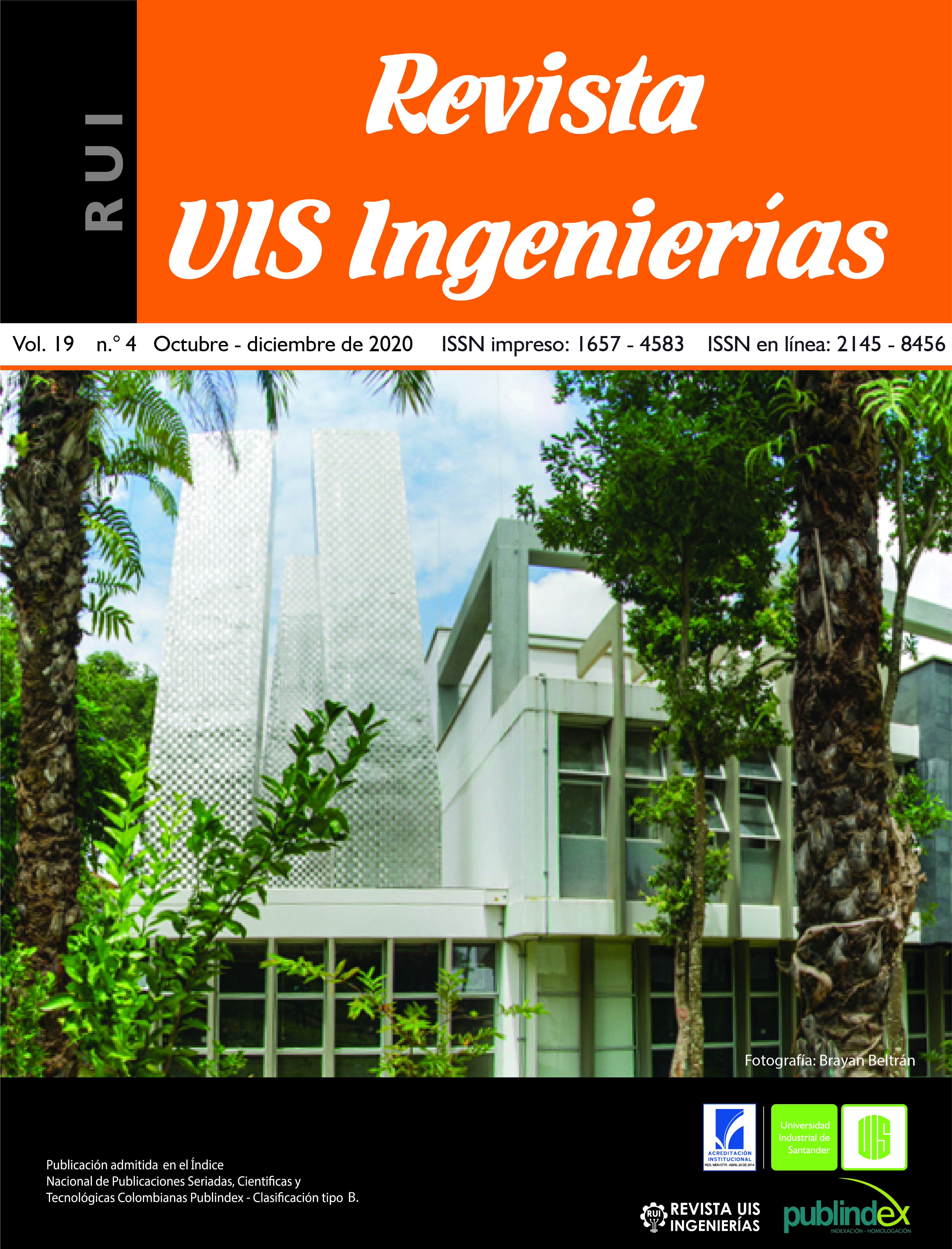Credit risk prediction in Colombia using artificial intelligence techniques
Published 2020-07-27
Keywords
- artificial intelligence,
- credit risk,
- decision making,
- decision trees,
- default
- financial institutions,
- models,
- loan default,
- neural networks,
- prediction ...More
How to Cite
Copyright (c) 2020 Revista UIS Ingenierías

This work is licensed under a Creative Commons Attribution-NoDerivatives 4.0 International License.
Abstract
In this paper, new models for credit risk prediction in Colombia are proposed by using different artificial intelligence techniques. These models can be used to support the risk management area in banks, and they aim to identify clients that could be in default, generating a possible credit risk for financial institutions. Three techniques are used to obtain the models (neuronal networks, decision trees, and support vector machines) that predict the next payment of a client’s fee based on basic data from the client and previous recorded installment payments. Decision trees turns out to be more accurate than the other techniques that have been used when predicting credit risk with a ROC area of 88.29%. The proposed models reach accuracies that are like some other papers in the state of the art and in some cases, they overcome models in other studies.
Downloads
References
[2] A. Gahlaut, Tushar, P. K. Singh, “Prediction analysis of risky credit using Data mining classification models”, 8th International Conference on Computing, Communication and Networking Technologies (ICCCNT), Delhi, 2017, pp. 1-7, doi: 10.1109/ICCCNT.2017.8203982
[3] S. V. Kulkarni, S. N. Dhage, “Advanced credit score calculation using social media and machine learning”, J. Intell. Fuzzy Syst., vol. 36, no. 3, pp. 2373-2380, 2019, doi: 10.3233/JIFS-169948.V
[4] H. R. Sanabila, W. Jatmiko, “Ensemble Learning on Large Scale Financial Imbalanced Data”, International Workshop on Big Data and Information Security (IWBIS), Jakarta, 2018, pp. 93-98, doi: 10.1109/IWBIS.2018.8471702
[5] J. Chaisuwan, N. Chumuang, “Intelligent Credit Service Risk Predicting System Based on Customer’s Behavior By Using Machine Learning”, 14th International Joint Symposium on Artificial Intelligence and Natural Language Processing (iSAI-NLP), Chiang Mai, Thailand, 2019, pp. 1-6, doi: 10.1109/iSAI-NLP48611.2019.9045452
[6] A. Al-qerem, G. Al-Naymat, M. Alhasan, “Loan Default Prediction Model Improvement through Comprehensive Preprocessing and Features Selection”, International Arab Conference on Information Technology (ACIT), Al Ain, United Arab Emirates, 2019, pp. 235-240, doi: 10.1109/ACIT47987.2019.8991084
[7] J. Bae, S. Lee, H. Seo, “Artificial Intelligence Techniques for Predicting Online Peer-to-Peer (P2P) Loan Default”, The Journal of Society for e-Business Studies, vol. 23, no. 3, pp. 207-224, 2018.
[8] Y. Li, “Credit Risk Prediction Based on Machine Learning Methods”, 14th International Conference on Computer Science & Education (ICCSE), Toronto, ON, Canada, 2019, pp. 1011-1013, doi: 10.1109/ICCSE.2019.8845444
[9] Z. Ereiz, “Predicting Default Loans Using Machine Learning (OptiML)”, 27th Telecommunications Forum (TELFOR), Belgrade, Serbia, 2019, pp. 1-4, doi: 10.1109/TELFOR48224.2019.8971110
[10] M. Malekipirbazari, V. Aksakalli, “Risk assessment in social lending via random forests”, Expert Systems with Applications, vol. 42, no. 10, pp. 4621-4631, 2015, doi: 10.1016/j.eswa.2015.02.001
[11] A. Byanjankar, M. Heikkilä, J. Mezei, “Predicting Credit Risk in Peer-to-Peer Lending: A Neural Network Approach”, IEEE Symposium Series on Computational Intelligence, Cape Town, 2015, pp. 719-725, doi: 10.1109/SSCI.2015.109
[12] J.H. Aboobyda, M.A. Tarig, “Developing Prediction Model Of Loan Risk In Banks Using Data Mining”, Machine Learning and Applications: An International Journal (MLAIJ), vol. 3, no. 1, pp. 1-9, 2016.
[13] J. Yan et al., “Mining social lending motivations for loan project recommendations”, Expert Syst. Appl., vol. 111, pp. 100-106, 2018, doi: 10.1016/j.eswa.2017.11.010
[14] M. Sudhakar, C. Reddy, “Two Step Credit Risk Assessment Model For Retail Bank Loan Applications Using Decision Tree Data Mining Technique”, International Journal of Advanced Research in Computer Engineering & Technology (IJARCET), vol. 5, no. 3, pp. 705-718, 2016.
[15] S. Eletter, S. Yaseen, G. Elrefae, “Neuro-based artificial intelligence model for loan decisions”, American Journal of Economics and Business Administration, vol, 2, no 1, pp. 27-34, 2010.
[16] A. Blanco, R. Mejias, J. Lara, S. Rayo, “Credit scoring models for the microfinance industry using neural networks: evidence from Peru”, Expert Systems with Applications, vol. 40, no. 1, pp. 356-364, 2013, doi: 10.1016/j.eswa.2012.07.051
[17] R. G. Lopes, R. N. Carvalho, M. Ladeira, R. S. Carvalho, “Predicting Recovery of Credit Operations on a Brazilian Bank”, 15th IEEE International Conference on Machine Learning and Applications (ICMLA), Anaheim, CA, 2016, pp. 780-784, doi: 10.1109/ICMLA.2016.0139
[18] A. Khashman, “Neural networks for credit risk evaluation: Investigation of different neural models and learning schemes”, Expert Syst. Appl., vol. 37, no. 9, pp. 6233-6239, 2010, doi: 10.1016/j.eswa.2010.02.101
[19] C. García. “Deudores bancarios empiezan a colgarse con sus obligaciones”, 2016. [En línea]. Disponible en: http://www.eltiempo.com/economia/sectores/deudas-sin-pagar-crecen-en-colombia-42539
[20] R. Flórez, J. Fernández, Las redes neuronales artificiales: Fundamentos teóricos y aplicaciones prácticas. La Coruña, España: Editorial Netbiblo, 2008.
[21] R. Lippmann, “An introduction to computing with neural nets”, en IEEE ASSP Magazine, vol. 4, no. 2, pp. 4-22, 1987, doi: 10.1109/MASSP.1987.1165576
[22] R. Hecht-Nielsen, Neurocomputing, Michigan, Estados Unidos: Addison-Wesley, 1990.

